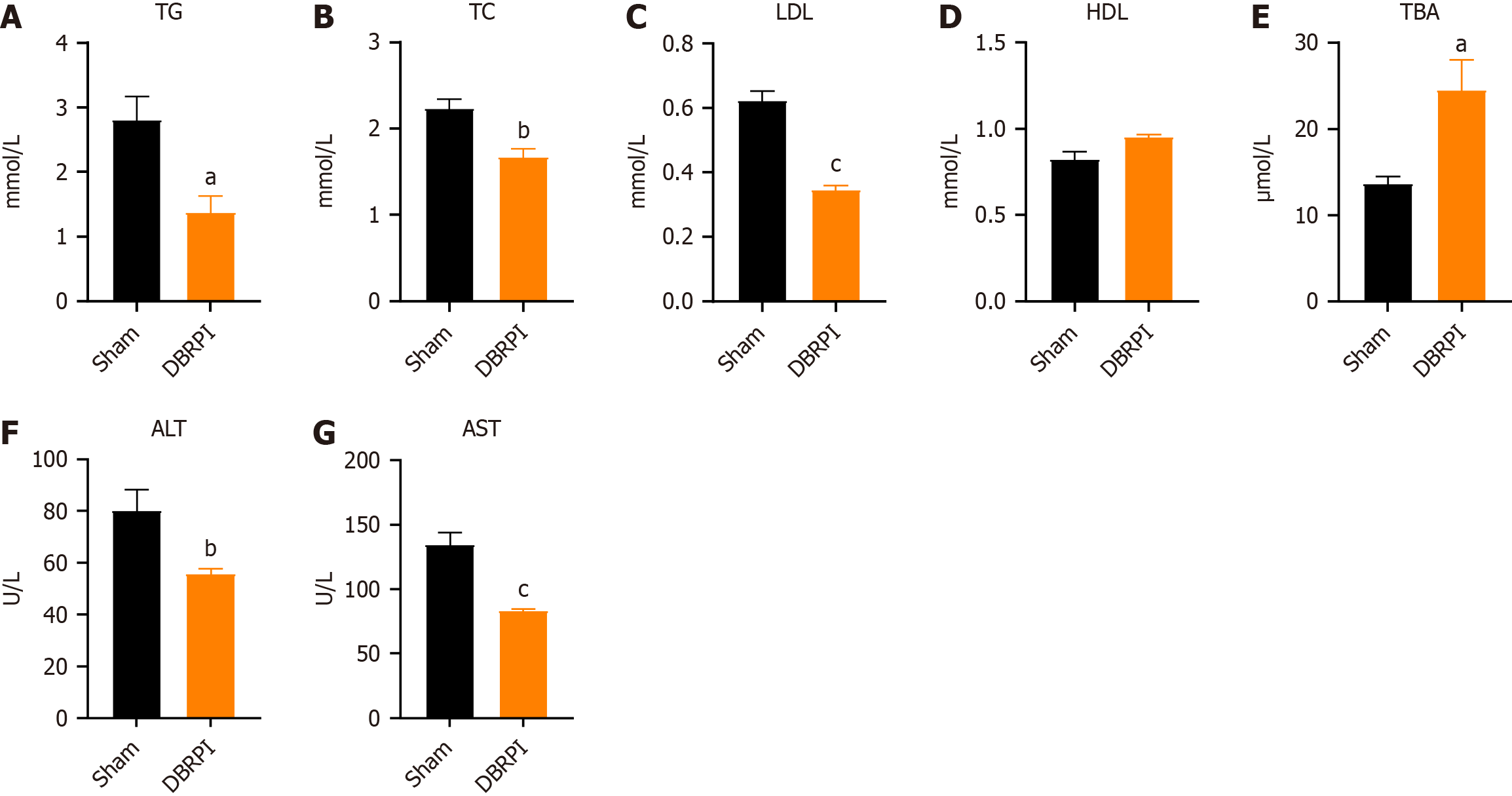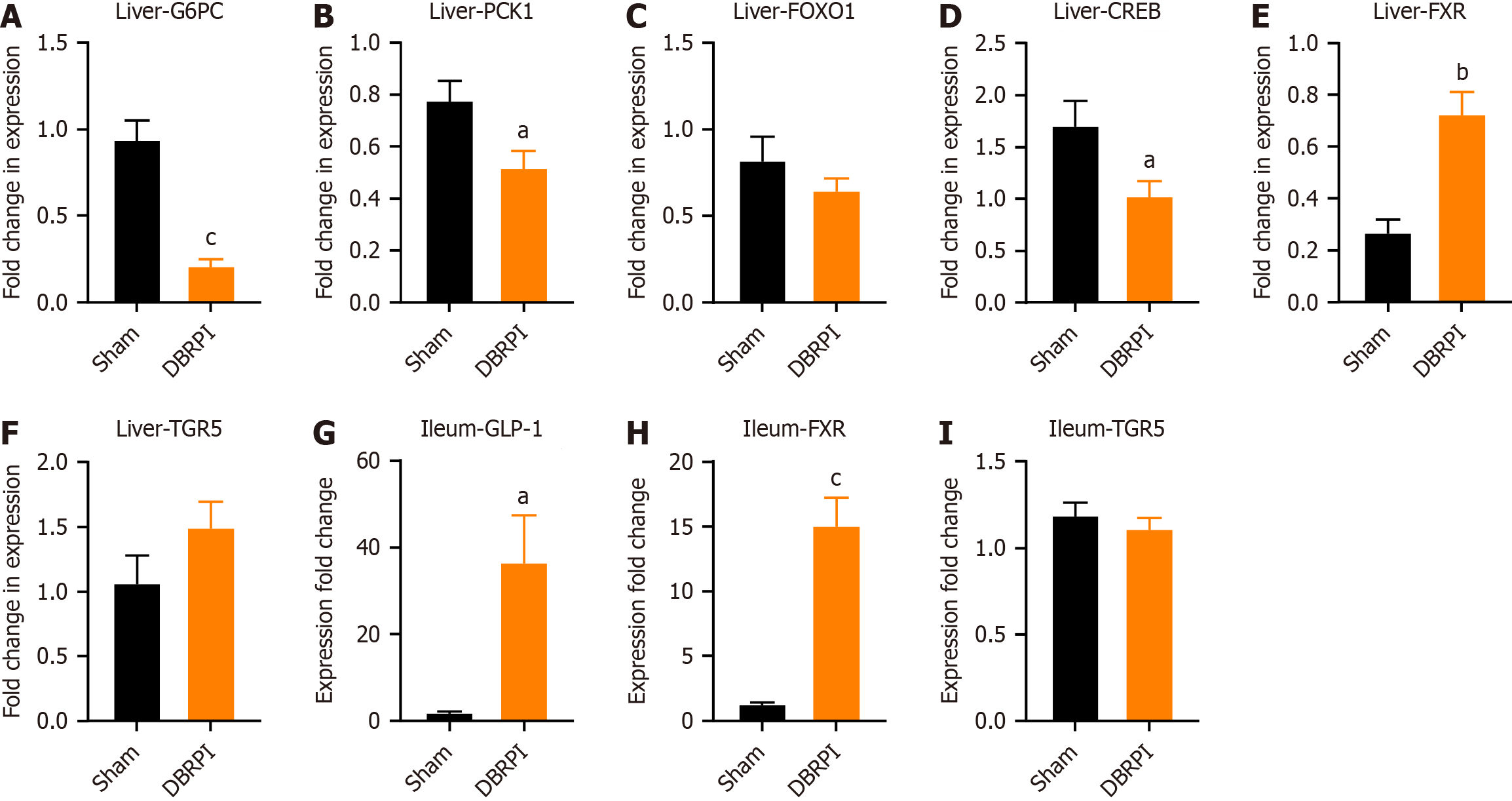Copyright
©The Author(s) 2025.
World J Gastroenterol. Nov 21, 2025; 31(43): 112483
Published online Nov 21, 2025. doi: 10.3748/wjg.v31.i43.112483
Published online Nov 21, 2025. doi: 10.3748/wjg.v31.i43.112483
Figure 1 Distal bowel resection with preservation of the terminal ileum reduces body weight and improves glucose tolerance in a time-dependent manner.
A: Changes in body weight; B: Changes in fasting blood glucose; C: Postprandial blood glucose in serum; D: Glycated serum protein; E: Area under the curve of the oral glucose tolerance test (OGTT); F: OGTT before surgery and at 2, 4, and 6 weeks after surgery. n = 6 for distal bowel resection with preservation of the terminal ileum, n = 6 for Sham. Data are presented as mean ± SEM, and statistical significance was determined by two-tailed Student's t-test or two-way ANOVA. aP < 0.05, bP < 0.01, cP < 0.001. DBRPI: Distal bowel resection with preservation of the terminal ileum; FBG: Fasting blood glucose; AUC-OGTT: Area under the curve of the oral glucose tolerance test; OGTT: Oral glucose tolerance test; PBG: Postprandial blood glucose; GSP: Glycated serum protein.
Figure 2 Distal bowel resection with preservation of the terminal ileum improves lipid metabolism and reduces liver transaminase levels.
A: Triglyceride; B: Total cholesterol; C: Low-density lipoprotein; D: High-density lipoprotein; E: Total serum bile acid; F: Serum alanine aminotransferase; G: Serum aspartate aminotransferase. Data are presented as mean ± SEM, and statistical significance was determined by two-tailed Student's t-test analysis. aP < 0.05, bP < 0.01, cP < 0.001. TG: Triglyceride; TC: Total cholesterol; LDL: Low-density lipoprotein; HDL: High-density lipoprotein; TBA: Total serum bile acid; ALT: Serum alanine aminotransferase; AST: Serum aspartate aminotransferase; DBRPI: Distal bowel resection with preservation of the terminal ileum.
Figure 3 Suppression of key gluconeogenic enzyme gene expression after distal bowel resection with preservation of the terminal ileum surgery.
A: Glucose-6-phosphatase, catalytic subunit; B: Phosphoenolpyruvate carboxykinase 1; C: Forkhead box O1; D: Cyclic AMP response element-binding protein; E: Expression of farnesoid X receptor (FXR) in the liver; F: Expression of Takeda G-protein coupled receptor 5 (TGR5) in the liver; G-I: Expression changes of glucagon-like peptide-1, FXR, and TGR5 in the terminal ileum. Data are presented as mean ± SEM, and statistical significance was determined by two-tailed Student's t-test or two-way ANOVA. aP < 0.05, bP < 0.01, cP < 0.001. DBRPI: Distal bowel resection with preservation of the terminal ileum; G6PC: Glucose-6-phosphatase; PCK1: Phosphoenolpyruvate carboxykinase 1; FOXO1: Forkhead box O1; CREB: Cyclic AMP response element-binding protein; FXR: Farnesoid X receptor; TGR5: Takeda G-protein coupled receptor 5; GLP-1: Glucagon-like peptide-1.
Figure 4 Significant changes in gut microbiota after distal bowel resection with preservation of the terminal ileum surgery.
A: Fir
Figure 5 Significant changes in fecal bile acid profiles after distal bowel resection with preservation of the terminal ileum surgery are cor
Figure 6 Mechanism diagram of improved glucose metabolism after distal bowel resection with preservation of the terminal ileum surgery.
7-KLCA: 7-ketolithocholic acid; FXR: Farnesoid X receptor; GLP-1: Glucagon-like peptide 1; G6PC: Glucose-6-phosphatase; PCK1: Phosphoenolpyruvate carboxykinase 1.
- Citation: Xu CY, Zheng ZH, Yang K, Wu RR, Cao JQ, Duan JY. Distal small bowel resection with preservation of the terminal ileum suppresses hepatic gluconeogenesis via the Prevotellaceae_NK3B31_group-mediated 7-KLCA-FXR axis. World J Gastroenterol 2025; 31(43): 112483
- URL: https://www.wjgnet.com/1007-9327/full/v31/i43/112483.htm
- DOI: https://dx.doi.org/10.3748/wjg.v31.i43.112483


















